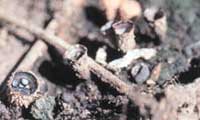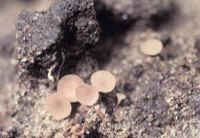The disease cycle begins with the germination of sclerotia at the soil surface. Sclerotia germinate to form mushroom-like structures called apothecia. Apothecia are tan, have a sponge-like texture and are 1/4 to 1/2 inch at maturity. They are found on the soil surface when the soil is moist and dim light is filtered through the crop canopy.
The number of apothecia is related to the number of sclerotia near the soil surface, soil moisture and temperature, and the timing and density of crop canopy closure. Apothecia will readily form under the canopy of a nonhost.
Apothecia of the white mold pathogen are frequently confused with reproductive structure of the bird’s nest fungus, a harmless fungus that grows on decaying organic matter. The common name of this fungus is derived from the brown, nest-like structures.
Plant infection begins mainly on dying soybean flowers
Under the cap of the apothecia, microscopic spores called ascospores are produced and forcibly ejected. The spores land on senescing flower petals that
adhere to emerging pods. The fungus grows from the flower petals, to pods, nodes and stems.
If adjacent plants come into contact with an infected plant, they may also become infected, but plant to plant spread of the pathogen is minimal and not as important as infection of blossoms.
Sclerotia form as overwintering structures
Hard, dark structures called sclerotia are formed from the vegetative tissue of the fungus (the mycelium) on and inside inside stems and pods. Some sclerotia fall to the soil surface. Sclerotia that form inside stems and pods are released when plants pass through the combine at harvest and are deposited on the soil surface.
Sclerotia will be also be positioned within the soil profile (plow layer) depending on the degree and type, or lack, of tillage.
Sclerotia are also removed from the field with the grain. Fortunately, they are not toxic to livestock, and are believed to be killed by the roasting process. All the beans that go through a roaster are brought up to temperature due to the type of flow-through process used in most machines. Temperatures of soybean grain reaches 290° F. for beans to be loaded out (flash-cooled) and 270° F for beans to be steeped in their own heat in a bin for a few hours. These temperatures are sufficiently high to kill sclerotia of the white mold fungus
White mold in Wisconsin
White mold disease cycle
White mold risk assessment
White mold management






